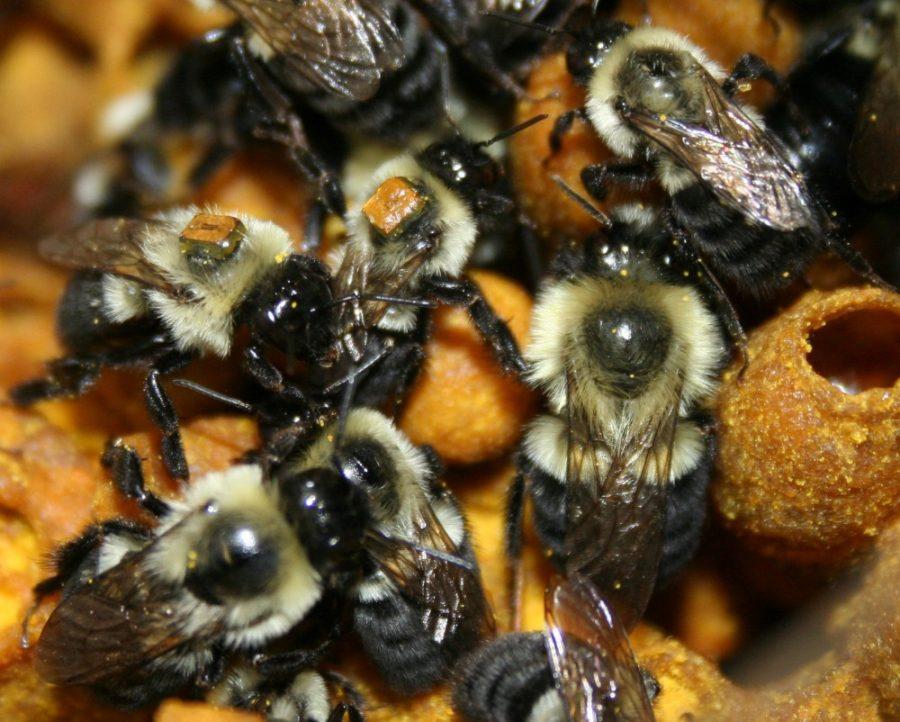An experiment focusing on the actions of foragers—bees that leave the hive in search of pollen or nectar—was recently conducted through UA’s Department of Ecology and Evolutionary Biology by former entomology doctoral student Avery Russell.
Russell’s research involved studying an artificial hive of bumblebees, which were given the option to forage from two artificial sources of pollen and nectar. By studying a bee’s trips to and from the hive, Russell was able to gather data on the specializations and efficiency of the foraging bees.
Because bees within a colony must divide their attention among various tasks, foragers will encounter deviations in their daily patterns and they must adapt to those variations. The type of deviation encountered could range from a change in food source to a shift in collection location. Russell’s research proposed that, in order to adapt to these variations, foragers can increase efficiency by avoiding multitasking and instead focusing on one task at a time in a given foraging day.
The goal was to examine the patterns of the bees to determine why specialization occurred and what impacts specialization had on other bees. “So, in this case what we’re interested in is figuring out whether bees are specializing on a given foraging task over shorter periods or their lifetime,” Russell said.
RELATED: UA researchers connect bee diet to gut bacteria
Traditionally, many entomologists argued that bumblebees are very general in their patterns of collection and pollination. Russell’s study has demonstrated that this may not be the case.
“The rationale behind the study is not just to look at whether or not foraging specialization is changing from short time scales to long time scales but also whether that specialization has any relationship to the efficiency of the worker,” Russell said.
Normally, these types of studies require a researcher to observe a hive for an extended period of time and record their findings and observations. Russell’s study made use of RFID—radio frequency identification—tags so that the actions of the bees could be observed without the limitations that tend to come with human eyesight.
The use of the RFID tags allowed the researchers to track the exact movements of collecting and foraging trips for multiple bees.
“This is the beauty of the RFID system, that we can get a complete foraging record for every single individual and every single foraging event that they make for their entire lives,” Russell said, adding that it “allows you to keep track of specialization patterns over the course of a day, over the course of a lifetime, and how those needs shift depending on what the colony is doing.”
In order to fully understand the data from the RFID tags, Russell enlisted the help of Sarah Morrison, a doctoral student in astronomy and planetary sciences. Morrison currently does research using astrophysical simulations to study how planets interact with debris disks. She was able to adapt one of her programs to compile and make sense of the data gathered regarding bee interactions.
RELATED: Biologists find key traits for species success
Morrison explained “[Russell] basically created this huge dataset based on the movements of bees. What was being recorded with the RFID readers was every time a bee moved in proximity to one of them, it recorded the date and the time.”
“If you want to look at, say, one bee in particular and figure out what are they doing over time, in order to be able to get that information from the data set, you need programming skills,” Morrison said.
“Very quickly, even just looking at what the hive is doing on a particular day, you generate very large files of data,” Morrison said. Using this program, Morrison was also able to help filter out the unusable data, such as bees that did not make full foraging trips, and gather the detailed data Russell needed from the hive.
By monitoring the bumblebees’ trips, Russell was able to conclude that the bumblebees are much more specific in their daily tasks than previously thought.
Follow Rebekah Ulmer on Twitter.









